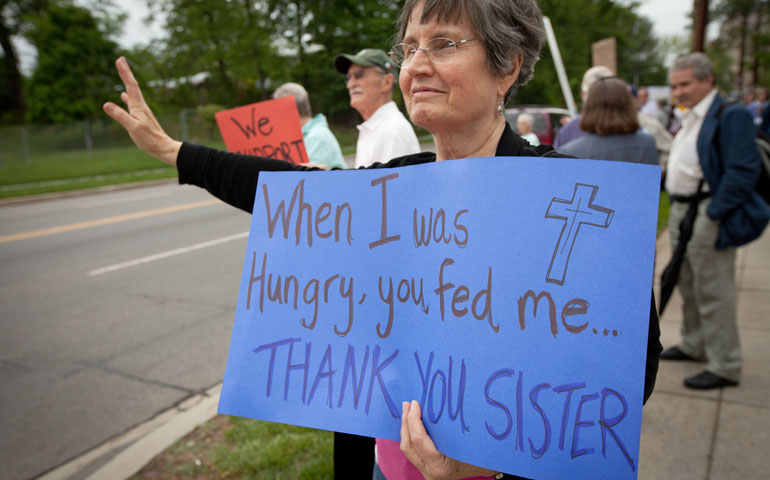
Arlene McGarrity of St. John the Baptist Church in Silver Spring, Md., demonstrates her support of women religious and the Leadership Conference of Women Religious outside the U.S. bishops’ headquarters May 8, 2012. (CNS/Nancy Phelan Wiechec)
As it turns out, the investigation of American nuns came squarely in the middle of Pope Benedict XVI’s eight-year reign. It angered those who’d pledged themselves to renewal and stirred barely suppressed glee in the minority whose concept of religious life was pre-Vatican II.
In the years leading up to that alarm, many religious communities belonging to the Leadership Conference of Women Religious had languished in the face of huge challenges, among them the financing of care for retired sisters and sheer survival.
Their position was further compromised by a successful public relations initiative to convince the public that adherents of the rival Conference of Major Superiors of Women Religious, certified by the Vatican in 1991 as a traditionalist alternative, were thriving as the result of their fidelity to true religious life while LCWR-affiliated groups were dying because they had abandoned their vows for worldliness and self-seeking.
No matter that the publicity was essentially wrong. It had an impact; news coverage focused on the joyous nuns in habits who did everything the old way and were booming. Renewal sisters found themselves in a defensive posture.
Then the thunderbolts struck from Rome, one aimed at gauging the orthodoxy of the hundreds of distinct communities, the other pointed directly at the loyalty of LCWR. Only the second verdict has been delivered, of course, and it indicted LCWR as acting outside church teaching by promoting forms of “radical feminism.” The pope told them to toe the line, with an implied “or else.”
The stunning strikes cast a sudden, critical spotlight on the creative ministries generated by sisters through renewal. Millions of Catholic laity recoiled at both the despotic tactics of the investigation and its seeming attack on the work of sisters. A groundswell of support for the “liberal” sisters arose at once and has continued; it was a long delayed thank-you.
The insult had backfired, at least in the short term. It revived pride in the sisters’ renewal mission and unleashed a flood of gratitude from Catholic beneficiaries of their service.
The size and strength of that uproar appeared to slow the Vatican’s hopes of quickly remedying beliefs and behavior it deemed un-Catholic. In the intervening months, the process has become bogged down.
It was clear what Rome was looking for: insubordination with regard to its ban on even discussing the ordination of women; laxity toward its central loyal tests against birth control, abortion or gay sexuality; softness in matters of ecumenical cooperation.
In fact, there was good reason to believe that dissenting views do exist widely among sisters, but voicing them openly risks sanctions.
When LCWR was charged last year with dissenting or remaining silent on these issues -- and theoretically placed under three bishops -- it set aside answering the charges directly, choosing instead to protest the nature and manner of the probes and calling for dialogue.
Now, as Benedict exits, matters between Rome and LCWR are at a standoff. Rome appears reluctant to forge ahead against the sentiments of vast numbers of Catholics. LCWR sisters enjoy popular support but there is no structure to sustain it.
The hot-button issues underscored by the Vatican remain front and center for all Catholics in general and all Catholic women in particular. The spotlight moment is passing, however, without evidence that the sisters and their lay advocates will have the wherewithal to explain and defend the case for reform.
Under Benedict’s aegis, the demand for conformity has been largely sidestepped. Exceptions like Roy Bourgeois, the Maryknoll priest excommunicated and defrocked for supporting women’s ordination to the priesthood, and Mercy Sr. Margaret Farley, sanctioned for “contradicting” church teaching on sexuality, have paid a price for publicly opposing Rome. Most others remain opposed privately but seek to remain in the church’s good graces.
During the current crisis, what is unsaid publicly looms large. LCWR hasn’t made a case for total equality of women -- that would require outspoken backing from the rest of the Catholic laity. Such an alliance could be formidable. But that kind of activism is hard to build and sustain. For the most part, the sisters have been hailed for their good works rather than for their implicit feminism (while the lingering question of whether a nun can be a feminist has again emerged).
For the most part, sisters have obeyed the Vatican’s order to remain silent about the investigations. It is a striking gesture of trust toward an institution that has heaped scorn on various aspects of renewal for decades. Their voices on some of the issues that matter most aren’t heard.
The implications of that silence extend to the writing of this piece. Five women with close ties to religious communities said they were unable to take on the assignment before this writer was approached.
Meanwhile, a solid rationale exists for biding time and waiting it out. The premise is part belief in progress, part John Henry Newman’s development of doctrine, part American optimism. It goes like this: Women’s (nuns’) causes will inevitably be vindicated because they are on the right side of history. Sisters therefore represent the future by continuing to model the ministries of justice and peace as renewed by Vatican II. It is a variation on passive resistance as practiced by Mahatma Gandhi and Dr. Martin Luther King Jr., except that the nuns’ agenda isn’t nearly as precisely spelled out.
Benedict leaves behind more friction over legitimate feminism than that which greeted him. Whether American sisters can use the sizeable collateral they have earned to further their largely unspoken conviction remains the pivotal question.
[Ken Briggs, author of Double Crossed: Uncovering the Catholic Church’s Betrayal of American Nuns, reported on religion for Newsday and The New York Times.]
